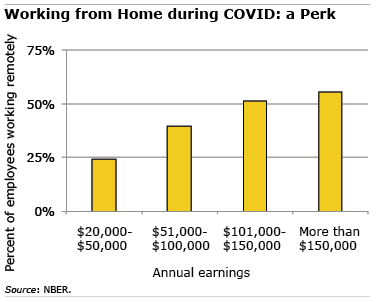
Working from Home: the Next Inequity
An impressive consensus has emerged around the benefits of working from home.
More employers have come to accept the practice after being pleasantly surprised at how productive their employees are. If remote workers were once viewed as insufficiently committed to the company, they no longer feel as marginalized. And people seem to like it – with the notable exception of the mothers juggling Zoom meetings and childcare.
An NBER study out this month estimates that about 20 percent of the workdays in this country, post-pandemic, will be carried out at home. That’s less than half the at-home time that was clocked last year as the pandemic raged but is multiples of the very low levels prior to COVID-19.
There is “little doubt that the stigma associated with [working from home] diminished during the pandemic,” concluded the study, based on a series of surveys last year. This seismic shift in workplace conventions “will stick long after the pandemic ends.”
But a second theme running through this research is just as important: the benefits of telecommuting flow mainly to the more educated, higher-paid labor force.
 More than 50 percent of U.S. workers earning more than $100,000 a year have been allowed to work at home, rather than in the office, giving them more protection from layoffs during the economic shutdowns and from COVID-19. On the other end of the spectrum are lower-paid and minority workers, who have been much more likely to lose their jobs and be exposed to the disease. Just 25 percent of employees earning under $50,000 work at home – and only 10 percent of the lowest-paid workers who didn’t complete high school work.
More than 50 percent of U.S. workers earning more than $100,000 a year have been allowed to work at home, rather than in the office, giving them more protection from layoffs during the economic shutdowns and from COVID-19. On the other end of the spectrum are lower-paid and minority workers, who have been much more likely to lose their jobs and be exposed to the disease. Just 25 percent of employees earning under $50,000 work at home – and only 10 percent of the lowest-paid workers who didn’t complete high school work.
Yet the desire to work at home is pervasive. Regardless of their income, years of education, or family situation, workers view it as a perk – so much so that most people said they would accept a pay cut if they could work remotely two or three days a week.
Another potential impact on equity in the study is the effect of remote work on commerce in the urban centers.
During the pandemic, commuting times were reduced by 61 million hours per day, including commutes into cities where the researchers estimate that office and other employees spent $300 per week in the restaurants and retail stores that employ lower-income workers.
Of course, some of these workers could benefit as more consumer spending flows to the outlying residential areas and suburbs, saving them time and money commuting into the city. Nevertheless, the researchers estimated that annual consumer spending in major cities like Manhattan and San Francisco will drop by hundreds of millions of dollars.
The pandemic hit lower-paid workers the hardest. And when the economy comes back, the early indications are that they won’t benefit as much from the dramatic changes under way in the workplace.
Read our blog posts in our ongoing coverage of COVID-19.
Squared Away writer Kim Blanton invites you to follow us on Twitter @SquaredAwayBC. To stay current on our blog, please join our free email list. You’ll receive just one email each week – with links to the two new posts for that week – when you sign up here. This blog is supported by the Center for Retirement Research at Boston College.
Comments are closed.







We miss the office. After a year of working from home, we crave the normalcy of it. And once we get back, we certainly won’t miss these 8 things about working from home. Check out this blog, and you may possibly feel the same: https://www.peoplehum.com/blog/8-things-i-wont-miss-when-wfh-is-over
I appreciate the commentary. Just would note re: the reference to “mothers juggling Zoom meetings and childcare,” – while I do think heavier burdens during the pandemic have in many cases fallen on mothers and there are plenty of articles to support that notion, I do know a number of fathers who have also been juggling Zoom meetings and child care. One of my very favorite things is a child showing up in the background on a Zoom call with a male colleague, it’s the great equalizer! Without calling out the heavier burden on mothers specifically or citing the research – only mentioning the mothers and not fathers here feels like buying into stereotypes about women/mothers in the workforce.